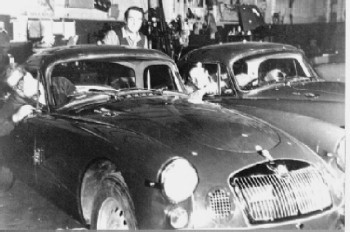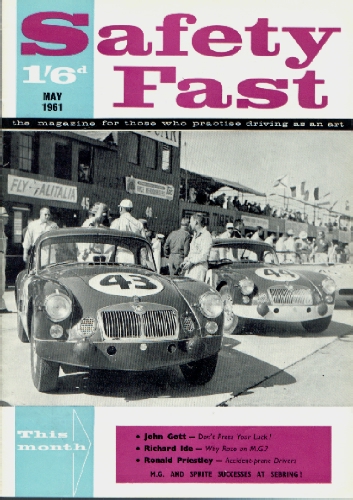This photo taken in the Comps Department appeared in Safety Fast around February of 1961. It shows Peter Riley on the left seated in #43 and John Whitmore sitting in #44. Standing in the middle is Bob Olthoff who was the reserve driver in '61. In addition to the white roundels and racing numbers a few other minor details would be added before the race. Works competition cars were generally trimmed out with door panels, carpet and, as |
can be seen in this photo, full headliners. The cars were tested and in order to get temperatures up to normal, the grill openings were partially blocked off. (The color photo on the home page shows these panels still in place as the cars arrived at the track in Sebring. Needless to say, they were quickly removed. ) Time being short both cars were dispatched to Southhampton where they were loaded aboard the luxury liner Queen Elizabeth bound for New York. They were then trucked to Sebring. |


The cover of Safety Fast from May 1961 shows the cars in the pit lane just before the start of the race. The #44 has had it's valance painted white for recognition purposes and both cars have had two large holes drilled in the valence. It took me a while to figure out why the holes were there. These cars were equipped for a 'quick lift' jack. There is an extra crossmember just behind the front valance with two blades that the jack engages. The jack is a tubular steel affair that is rolled under the car and by pushing down the entire front end is lifted. Very similar to what is used in F1 today. Similar fittings were also at the rear. Practice must have revealed that the pit crew could not see the jacking points when trying to change tires. The jacking blades were painted white and sight holes drilled in the aluminum valence. The white spot in the center of the valence is a chrome plated cap that snaps into the hole for the handcrank (More about that later). Another detail are the clear plastic stone guards over the headlamps these were also used on the works rally cars. From 1953 until 1972 the Sebring 12 Hour Race was an FIA sanctioned event, placing it on a par with LeMans in the eyes of manufacturers and drivers. Though the fastest cars and best drivers in the world were on hand, Sebring various classes permitted races within the race. |
The MGAs were not there to do head to head battle with Ferrari and Maserati ( although both MGs finished ahead of the highest placed Maserati in '61) but were there to contend the GT9 class against the likes of Sunbeam and Elva. This they did very convincingly taking 1st and 2nd in class, the best finish for MGAs at |
Sebring, at a speed that would have been good enough for a 6th overall only two years earlier. After the race, the cars were sent to Ship 'n Shore motors in West Palm Beach where the numbers were striped off and the roof and fender lights were removed. Both cars were then resprayed black and sold off. The #44 car was later raced in SCCA events and received a roll bar and properly mounted seat belts, the #43 remained unchanged indicating that it was never raced again though it may have been used for rallies. |

This last photo was taken by team driver Ed Leavens in Avon Park, Florida where the BMC teams were based. In 1961 Ed drove an Austin Healy Sprite with John Colgate but he had been been one of the MGA team drivers in '57, '59 and '60. The backs of the red Microcell seats and the interior trim can be seen through the windows. The signs in the windows read "No Water" so this was probably taken just after the cars arrived. |

Photo by Ed Leavens |